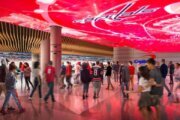By LUCY WESTCOTT
Capital News Service
WASHINGTON – America’s 12 largest supermarkets and retailers are failing to curb their hydrofluorocarbon (HFC) emissions, adding large amounts of greenhouse gas to the environment, a new report published Thursday finds.
Eight of the 12 stores, called the “dirty dozen” by the Environmental Investigation Agency, which published the report, have locations in Maryland. Costco, the worst-ranked retailer, has 10 stores in the state. Whole Food Markets has eight Maryland locations.
The Environmental Investigation Agency is an independent non-profit that conducts investigations about issues affecting wildlife and the environment. Retailers examined by the group also include Target, Walmart and the Delhaize Group, whose brands include Food Lion and Bottom Dollar Food.
Hydrofluorocarbons are a class of compounds used in commercial refrigeration and air conditioning units. They are the fastest growing greenhouse gas, and by 2050 will make up 9 percent of global C02 emissions, according to the Environmental Investigation Agency.
“The results from the survey are not just disappointing but shocking given that climate-friendly alternative technologies are available in the marketplace,” said Allan Thornton, president of the Environmental Investigation Agency.
Some U.S. retailers are taking steps to reduce their HFC emissions.
Whole Foods is opening an HFC-free store in Brooklyn later this year, and several stores have moved towards using a combination of HFCs and natural refrigerants in their cooling systems. Wal-Mart has 125 stores and two Sam’s Club locations using the hybrid technology.
But all 12 stores lag far behind their counterparts in Canada, Japan and the European Union, the Environmental Investigation Agency said.
The nation’s largest retailer, Walmart, is taking steps to reduce its overall emissions.
“At Walmart, we’re committed to reducing our carbon footprint, and we’re working with our suppliers to do the same,” said Christopher Schraeder, senior manager of sustainability communications at Walmart, in an email.
“Eighty percent of our direct GHG (Greenhouse Gas) footprint comes from the energy used to power our buildings, including HVAC, lighting and refrigeration. By designing whole-system refrigeration solutions, we are working to address both the refrigerant gas pollution and the energy intensity of these systems,” Schraeder said, in the email.
Unlike refrigerants like chlorofluorocarbons (CFCs) and hydrochlorofluorocarbons (HCFCs), HFCs don’t deplete the ozone layer, as they don’t include chlorine. But they are greenhouse gases with the potential to contribute to global warming, said Robert Rhew, an atmospheric scientist and professor at the University of California, Berkeley.
“HFCs rank 6th in terms of the human produced greenhouse gases, after carbon dioxide, methane, nitrous oxide, HCFCs and CFCs,” Rhew said. “But they are rapidly increasing in the atmosphere, about 10-15 percent per year, and will therefore become an ever greater greenhouse [force].”
Retailers were judged on criteria including their use of HFCs and corporate policy regarding their phase out and reduction. Whether or not they are members of the Consumer Goods Forum, an international network of the world’s largest retailers, or the Environmental Protection Agency’s GreenChill Partnership, a joint effort between the agency and retailers to reduce emissions from refrigerants, was also considered.
The Environmental Investigation Agency recommends that retailers begin reducing HFCs in 2015.
The impact of HFCs on the environment depends on which type is emitted, as some HFCs are worse for the environment than others, Rhew said.
“If we can replace the current mix of HFCs with those with much shorter atmospheric lifetimes (they break down in the atmosphere more readily), then the impact can be minimized,” Rhew said.
The EPA estimates that leakage from an average supermarket refrigeration system is 1,556 metric tons of CO2 emissions a year, which is the equivalent of the greenhouse gas emissions of 324 passenger cars.
President Barack Obama highlighted the reduction of HFCs as a key part of his June 2013 Climate Action Plan. The report states HFC emissions are expected to triple by 2030 and double from their current level of 1.5 percent to 3 percent of greenhouse gas emissions by 2020.
Copyright 2013 by Capital News Service. All Rights Reserved.







